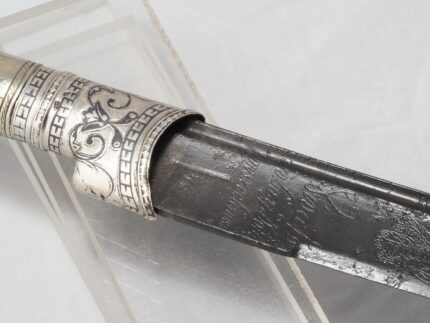19th-Century Polish Sword Unearthed in Bulgaria
A sword in a Bulgarian museum has been identified as a 19th-century Polish nationalist sabre. It was discovered near the city of the Veliko Tarnovo in northern Bulgaria where curators from the Archaeological Museum saw it had a Polish inscription.
An expert from the University of Warsaw recognized the inscription Vivat Szlachcic Pan I foundation wojska (“Long live the Noble Lord and founder of the army”) and engraved iconography as one wielded by Polish patriots during the January Uprising against Russia’s autocratic rule.
The January Uprising (1863-1864) was one several attempts by Polish patriots to re-establish the Polish-Lithuanian commonwealth in the Russian Kingdom of Poland. Russian Poland was carved out of the Duchy of Warsaw at the Congress of Vienna in 1815.

The kingdom was supposed to be largely autonomous, nominally under the rule of the Tzar, but governed by its own parliament, defended by its own army and bound by the Polish constitution.
Tzar Alexander I and his successor Nicholas I had other plans, and between the two of them, they quashed the country’s traditional religious and political freedoms and made it a puppet state of the Russian Empire.

Nationalist resistance to Russian rule grew in the wake of its losses in the Crimean War. In January 1863, pro-Russian Polish aristocrat Aleksander Wielopolski, adjutant to the Polish viceroy, ordered the conscription of Polish nationalists into the Imperial Russian Army for 20-year terms.
He knew the movement for Polish independence was working up to an uprising and thought strongarming its young men into military service would break up the movement. Instead, it triggered the very uprising he was trying to prevent.
It was the longest uprising for Polish national unity under Russian rule, but it too ultimately collapsed under the weight of Russia’s superior military strength.
The results were brutal — executions, mass deportations to Siberia, punitive taxation, the complete erasure of the Polish language in government and schools and the replacement of all Polish government officials with Russians.
The newly-discovered sword was inscribed during this period. The curved karabela type, a Polish sabre used during the halcyon days of the Polish-Lithuanian Commonwealth in the 17th and 18th centuries, was an emblem of Polish culture and independence.
During the uprisings of the 19th centuries, they were engraved with slogans and imagery harkening back to the Commonwealth.
[Professor Piotr Dyczek] added: “The sabre was probably the spoils of an officer of the Tsarist army who participated in the suppression of the January Uprising in 1863 and 1864, who then fitted it with a silver hilt typical for a shashka – a sabre with an open hilt with a split pommel.”

Presumably that Russian soldier took the sword out of Poland after the uprising was suppressed. At that time, Bulgaria was under the Ottoman rule as it had been since 1393, but a decade after the January Uprising, Bulgaria had an uprising of its own in April 1876.
Russia was a fan of this one, though, since wresting the Balkans out of Ottoman hands would extend their sphere of influence which had been whittled away by the Crimean War.
They jumped on the opportunity and the Russo-Turkish War began in 1877. It ended when the Imperial Russian Army took Tarnovo in July 1878. The Polish sword was probably used (and lost) in that battle.
